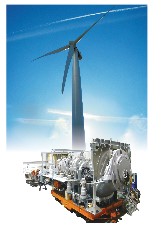
Wind energy will continue
to the backbone of India's
renewable energy pursuits.
With an average net wind
power capacity addition of
1.7 GW per year over the
past five years, the focus
on wind energy appears to
be getting only sharper. A
key enabler to India's wind
energy pursuits will be a
sound manufacturing base
for towers, turbines and
related components. This
special study by
Venugopal
Pillai brings you closer to
recent developments in the
Indian wind power
equipment industry, and
attempts to present the key
challenges in store.
The wind turbine industry in India is fast evolving as it
gears up to meet the huge growth in wind energy
installations. In recent times there has been
significant interest in global wind turbine manufacturers
setting up shop in India, some on their own and others in
collaboration with Indian partners. There is also an
upcoming breed of domestic companies that are raring to go
solo in the manufacture of low-rating wind turbines.
Average size of WTG installations |
(kW) |
|
2004 |
2005 |
2006 |
2007 |
2008 |
2009 |
| China |
771 |
897 |
931 |
1,079 |
1,220 |
1,360 |
| Denmark |
2,225 |
1,381 |
1,875 |
850 |
2,277 |
2,368 |
| Germany |
1,715 |
1,634 |
1,848 |
1,879 |
1,916 |
1,977 |
| India |
767 |
780 |
926 |
986 |
999 |
1,117 |
| Spain |
1,123 |
1,105 |
1,469 |
1,648 |
1,837 |
1,897 |
| Sweden |
1,336 |
1,126 |
1,138 |
1,670 |
1,738 |
1,974 |
| UK |
1,695 |
2,172 |
1,953 |
2,049 |
2,256 |
2,251 |
| USA |
1,309 |
1,466 |
1,466 |
1,669 |
1,677 |
1,731 |
| Source: GWEC |
It is estimated that the total annual capacity of WTG (wind
turbine generators) in India is currently anywhere between
3,000 mw and 4,000 mw. Precise numbers are difficult as
several players are new and production has yet to stabilize. It is
encouraging to note that over the next 2-3 years, India's WTG
manufacturing capacity could be augmented by at least 1,000
mw, given the ambitious plans of existing and new players.
The Indian manufacturing base is projected to serve both
the domestic and international markets. According to
Indian government estimates, exports of indigenously made
wind turbine generators amounted to $600 million
(around

2,800 crore) during 2009-10, destined to countries
like Australia, China, Brazil, USA, Portugal and Spain.
Exports of WTG components and blades were valued at
another $6 million in that year.
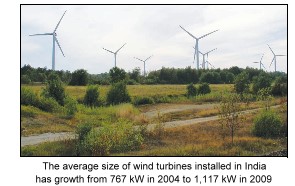
Currently, there are around 20 manufacturers that make
turbines of 250kW or higher. There are of course small local
manufacturers that make turbines of lower rating but their
market share is declining as such equipment is fast getting
obsolete. Wind turbine installations in India are currently of
600KW or higher.
The WTG manufacturing base in India is quite sound with
practically all leading global names like Enercon, Vestas,
Siemens, Vensys, AMSC, Gamesa, etc already present in the
subcontinent. In fact, domestic company Sulzon is amongst
the global wind energy giants, both as an equipment
manufacturer and power producer.
IFC makes first exposure to
Indian WTG industry |
 International Finance Corporation, part of
the World Bank Group, recently made its
first investment in an Indian wind turbine
manufacturer. IFC has decided to provide
€11 million loan to Gamesa Wind Turbines
Pvt Ltd that is building a wind turbine
assembly unit in Chennai, Tamil Nadu.
IFC's loan will support Gamesa's plans to
scale up its assembly capacity in India over the next two years.
"Our project with Gamesa represents IFC's first investment in a
wind-turbine manufacturer in India, and we are committed to
supporting energy generation from renewable sources to reduce
greenhouse-gas emissions," said Sergio Pimenta, IFC Director
for Manufacturing in Asia. "The investment will help address
India's energy deficit and sustain its forecasted trajectory of
economic growth," he added. International Finance Corporation, part of
the World Bank Group, recently made its
first investment in an Indian wind turbine
manufacturer. IFC has decided to provide
€11 million loan to Gamesa Wind Turbines
Pvt Ltd that is building a wind turbine
assembly unit in Chennai, Tamil Nadu.
IFC's loan will support Gamesa's plans to
scale up its assembly capacity in India over the next two years.
"Our project with Gamesa represents IFC's first investment in a
wind-turbine manufacturer in India, and we are committed to
supporting energy generation from renewable sources to reduce
greenhouse-gas emissions," said Sergio Pimenta, IFC Director
for Manufacturing in Asia. "The investment will help address
India's energy deficit and sustain its forecasted trajectory of
economic growth," he added.
With 11 GW of installed wind capacity, India is the
fifth-largest wind market in world. Since 2005, the country has
seen a steady increase in installations, a statement by IFC noted.
|
Over the past year, there has been a spurt in the plans of
multinationals planning to set up manufacturing facilities for
WTGs. It is not only about growth in the number of players, it
is more about the elevation in technology standards. For
instance, the average size of WTG installations, measure in
terms of turbine capacity is poised to increase substantially
from the current 1.12 mw (see table). India might soon have
direct-drive turbines that can harness electrical energy even
from low-velocity winds.
The following is a summary, over the past one year or so,
of prominent names that have announced their plans of
entering or furthering their presence in the Indian WTG and
components market.
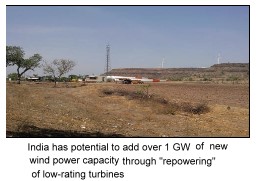 Siemens:
Siemens: This German engineering giant recently
announced plans of producing its SWT-2.3-113 (Direct
Drive) wind turbine in India. This 2.3-mw WTG with a
direct drive is specially designed for low-velocity
conditions. Siemens will manufacture this and other
turbines at Vadodara, Gujarat. The production at Vadodara
is slated to commence in 2013 with an annual capacity of
250 mw which will be scaled up to 500 mw by 2015 to meet
market demand. The company is additionally investing in
an R&D technology center at Vadodara. Late last year,
Siemens announced its plans of entering the renewable
energy business in India. Apart from wind energy, Siemens
will also pursue opportunities in solar power equipment.
Kenersys: Kenersys India, part of the Kalyani (Bharat
Forge) Group, very recently launched its new K100 2.5-mw
turbine. Equipped with Kenersys' "Synerdrive" technology,
the turbine will be manufactured at the newly-inaugurated
Baramati plant in Maharashtra. The turbine was launched
in the global market in 2007 and is being used by Vattenfall,
considered as amongst the largest wind power utility
globally. The Baramati plant is set up over an area of 35 acres
and a built up area of 5,600 sqm. Apart from the K100
turbine, the production facility will also manufacture the
K82 2.2-mw turbine.
WTG Manufacturers in India* |
Company |
WTG Ratings |
(KW) |
| Elecon Engineering |
600 |
| Enercon India |
800 |
| Essar Wind |
1500 |
| Emergya Wind Technologies |
750, 900, 2000 |
| Gamesa |
850, 2000 |
| GE Wind |
1500, 1600 |
| Ghodawat Energy |
1650 |
| Global Wind Power |
750, 2500 |
| Inox Wind |
2000 |
| Kenersys India |
2000 |
| Leitner-Shriram |
1350, 1500 |
| Pioneer Wincon |
750 |
| ReGen Powertech |
1500 |
| RRB Energy |
600, 1800 |
| RK Wind |
600 |
| Siemens |
2300 |
| Suzlon |
600, 1250, 1500, 2100 |
| Vestas India |
1650, 1800 |
| WinWinD |
1000 |
| Xyron Technologies |
1000 |
| *List is not exhaustive; excludes makers of low-rating WTGs |
| Source: GWEC |
Gamesa: In March this year, Gamesa, the Spanish wind
energy company announced that it would invest in a new
blade and nacelle factory and a tower factory (in joint venture)
in India. It also launched its R&D Centre at Sholinganallur in
Chennai. Gamesa had launched its operations in India in
February 2010 with setting up of an Indian subsidiary, Gamesa
Wind Turbines Pvt Ltd. The Indian venture of Gamesa has
notched up an impressive turnover of about

1,000 crore in its
first year in India and has exciting plans for the coming years.
Gamesa India is pioneering the Re-Powering initiative which
aims at using the existing wind energy resources on site more
efficiently, with technically advanced and high performance
turbines. (Re-powering is discussed separately in this story.)
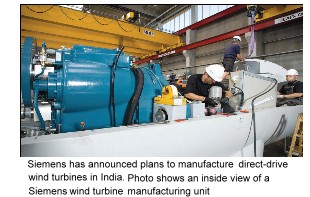 Powergear & Gestamp JV:
Powergear & Gestamp JV: In March this year, Chennaibased
Powergear Ltd formed a 60:40 joint venture with
Gestamp of Spain. The joint venture will invest

150 crore
to set up a facility for the manufacture of wind towers. The
plant of Gestamp Powergear Windsteel is coming up on 20
acres in the Sri City industrial estate, some 60 km north of
Chennai. Gestamp is a €5 billion company that is into a
variety of businesses, but mainly in the supply of cut and
pressed sheet metal forms to the automotive industry.
Powergear is a

140-crore company that makes electrical
equipment, such as busducts, and has among its customers,
big names such as GE, Mitsubishi Electric, Siemens, ABB
and Alstom. The upcoming plant at Sri City, expected to be
operational by December, can produce 400 towers a year,
with an estimated market value of

500 crore.
RRB Energy: RRB Energy has planned to start
manufacture of 1.8-mw capacity wind turbines. The
company is also in the process of expanding its range of
blades required for WTGs with the inclusion of the 13m
length blade for the 225KW turbine, in its existing
portfolio. The company's second phase of expansion at its
existing manufacturing site at Poonamallee, Chennai is in
an advanced stage of completion. This expansion involves
an investment outlay of around

100 crore, which is likely
to be completed this year. On completion, the company
expects to achieve an overall production capacity of 700
mw during FY12.
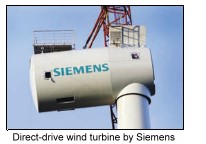 RE-POWERING
RE-POWERING
The gradual increase in India's WTG capacity is explained by
the huge wind power potential that the country is endowed
with. Official estimates suggest that India's gross wind power
potential is an astounding 45 GW of which only 13.065 GW
was harnessed as of end-December 2010. Hence around 70 per cent of the potential yet remains untapped. Over the past 5-7
years, the average annual addition of new wind power
capacity has been in the range of 1.3 GW to 2.2 GW. However
in the years to come, the average annual growth in capacity is
likely to be much more and this would warrant the need for
matching WTG manufacturing capacity.
Leading Wind Energy Nations |
Rank |
Country |
Capacity*
(MW) |
%
chg |
%
share |
| 1 |
China |
44,733 |
73.4 |
22.7 |
| 2 |
USA |
40,180 |
14.5 |
20.4 |
| 3 |
Germany |
27,214 |
5.6 |
13.8 |
| 4 |
Spain |
20,676 |
7.9 |
10.5 |
| 5 |
India |
13,065 |
19.6 |
6.6 |
| 6 |
Italy |
5,797 |
19.6 |
2.9 |
| 7 |
France |
5,660 |
23.7 |
2.9 |
| 8 |
UK |
5,204 |
22.6 |
2.6 |
| 9 |
Canada |
4,009 |
20.8 |
2.0 |
| 10 |
Portugal |
3,898 |
10.3 |
2.0 |
| 11 |
Denmark |
3,752 |
8.3 |
1.9 |
| 12 |
Japan |
2,304 |
10.5 |
1.2 |
| 13 |
Netherlands |
2,237 |
1.0 |
1.1 |
| 14 |
Sweden |
2,163 |
38.7 |
1.1 |
| 15 |
Australia |
1,880 |
9.8 |
1.0 |
| |
Grand Total |
197,039 |
24.0 |
100.0 |
*Capacity and % share as of December 2010
% chg is with respect to December 2009 |
One of the most interesting aspects of wind energy
development has been the evolving phenomenon of "repowering".
Most of India's wind power capacity during the
early years of development was through low-rating
turbines of 500 kW or lower. This was in keeping with the
technology available then. It is estimated that 46 per cent of
the total WTGs installed in India, as of March 2010, were of
500 kW or lower. The aggregate capacity of these turbines,
estimated at 2,331 mw, was around 18 per of the total
capacity as of given date.
Secondly, developers built wind farms for the sake of tax
concessions. Hence, in the minds of the developer, the
efficiency of the installation reduced to secondary importance.
It is also felt that India's gross assessed wind power potential of
45 GW was made under the assumption of low-rating turbines
(those of height up to 60m). Matters are very different now,
and experts feel that India's wind power potential, if assessed
now, could be even twice of the said figure.
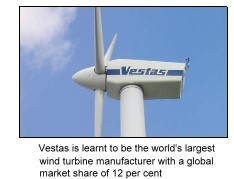
Advancement in technology has led to a phenomenon of "repowering",
which means that old low-rating turbines are being replaced by high-rating turbines. Re-powering offers the
unrivalled advantage of increasing the installed capacity of a
wind farm without any expansion in geographical footprint
and, in many cases, without much change to the associated
power transmission infrastructure.
Global Wind Energy Council (GWEC) has estimated that
as of March 2009, Tamil Nadu had the highest re-powering
potential of 800 mw followed by states like Gujarat,
Maharashtra, Andhra Pradesh and Karnataka. Although repowering
is a strong technical possibility, there could be
some difficulties in its execution, GWEC feels. Firstly, repowering
could lead to a reduction in number of turbines
since there will not always be a "one-for-one" replacement.
The issue of ownership needs to be dealt with carefully,
more so if the land has multiple owners. Power utilities that
have signed long-term power purchase agreements may not
be interested in revising the agreements. De-commissioning
of the old turbines and their disposal would involve a cost
that needs to be assessed carefully, GWEC feels. The most
important aspect here is that there is currently no
government policy for re-powering of old wind turbines. A
suitable policy addressing all the aforementioned issues
could expedite the re-powering endeavour.
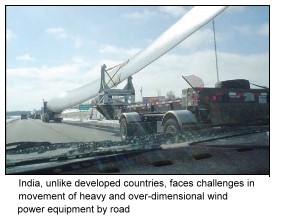 CHALLENGES
CHALLENGES
As earlier discussed, wind energy will make the biggest
contribution to India's renewable pursuits. In the ongoing XI
Plan period, a total of 24,000 mw of renewable energy capacity
is targeted for addition. Out of this, wind energy is expected to
contribute 10,500 mw representing 75 per cent of the target.
Going by the performance so far, wind energy is expected to
even exceed its target. From an average of 2 GW of new
capacity additions per year now, wind energy is likely to
contribute over 3 GW in the coming years. Thus, creation of
domestic manufacturing capacity is inevitable. Besides, India
is also being seen as a hub to export sophisticated turbines to
the developed markets.
While India is fast magnetizing private capital in wind
turbine industry, inasmuch as it is doing in the area of wind
power development, there are challenges that must be met.
Some challenges are inherent to the manufacture of
equipment while others relate to supply chain management
and logistics-related issues that could impinge on the pace
of wind power capacity creation.

With respect to manufacturing of equipment, there are
concerns in the form of very volatile and rising prices of key
inputs-steel and copper. The domestic market has limited
availability of specialized material like cold-rolled steel and
high-tensile structural steel, industry experts say. This
Installation of high-rating turbines warrants the need for heavy-duty cranes results in heavy dependence on imports. The Indian foundry industry also needs to modernize to facilitate the casting of
heavy and large components related to megawatt-sized
turbines, experts feel. Wind turbine manufacturing is a
fabrication-oriented industry. While India has adequate
vendors for fabrication of steel components, there are issues
regarding timely delivery and consistency in quality. Experts
also suggest that India currently has limited number of
manufacturers of precision components like gearboxes,
bearings and brakes. Growth in domestic capacity in these
critical areas could prove beneficial to the industry.
Wind turbine components |
 Acomplete wind turbine has the following components: blades,
controller, gearbox, generator, nacelle, rotor and tower. Most
turbines have three blades, although there are two-blade turbine
models. Blades are generally 30m to 50m in length, with the most
common size being 40m. There is a controller in the nacelle and
one at the base of the turbine. The controller monitors the
condition of the turbine and monitors the movement. Many
turbines have a gearbox that enhances the rotational speed of the
shaft. A low-speed shaft feeds into the gearbox and a high-speed
shaft feeds out from the gearbox into the generator. Some turbines
use direct-drive generators that can produce electricity at lower
speeds. Such turbines do not need a gearbox. A generator
converts mechanical energy produced by the rotation of the
turbine into electrical energy. The nacelle houses the main
components of the wind turbine such as the controller, generator,
gearbox and shafts. The rotor includes all the blades and the hub
(that part to which the blades are attached). Towers are strong steel
tubes, usually 60m to 80m in height, on which the nacelle and
rotor stand. Some towers have two or three sections to facilitate
transportation and installation. |
Serious challenges also exist in execution of wind power
projects. This can adversely affect the capacity utilization of
the domestic WTG industry. Amongst the biggest
challenges that wind power projects face is inadequate
logistics support and paucity of construction equipment.
Experts maintain that even if India's wind power potential is
to the tune of 45 GW, its realization depends on the ease and
pace at which projects can be executed. In this respect, some
potential will continue to remain "technical" in nature. In
the coming years, India will see widespread deployment of
multi-megawatt turbines, even those up to 2.5-mw.
Transportation of such heavy equipment to project sites can
be quite a challenge. The assembly for a single turbine could
be up to 60 tonnes, creating complexities in logistics. It is
even learnt that there are not many crane suppliers for super heavy
lifts causing a demand-supply mismatch resulting in
an inordinately high pricing regime.
 CHINESE SWEEP
CHINESE SWEEP
Till around four years ago, China was nowhere in the
reckoning when it came to wind power. Today, China has the
largest installed wind power capacity in the world, upsetting
the positions of erstwhile leaders like USA, Germany, Spain
and even India. Let us take a close look at the numbers. As of
December 2010, China had 44.7 GW of wind power
installations, accounting for over a fifth of the global capacity.
Over 95 per cent of China's present wind power capacity was
added in the last four years alone. In 2010 (January to
December), the country added as much as 18.9 GW of new
capacity—comparable to what the rest of the world did
collectively during the period. By 2015, experts feel that
China's total wind power installations could cross 129 GW,
which means an annual growth of over 22 per cent.
World's leading WTG companies |
Company |
Headquarters |
Market share (%) |
| Vestas |
Denmark |
12 |
| Sinovel |
China |
11 |
| GE |
USA |
10 |
| Goldwind |
China |
10 |
| Enercon |
Germany |
7 |
| Gamesa |
Spain |
7 |
| Donfang DEC |
China |
7 |
| Suzlon |
India |
6 |
| Siemens |
Germany |
5 |
| United Power |
China |
4 |
| Source: Various reports |
Having made a mark in wind energy installations, China is
also seen slowly penetrating the global WTG market and India
is no exception. Reliable reports suggest that China today has
four of its manufacturers in the world's top ten makers of wind
turbines. Sinovel of China is the world's second-largest manufacturer of WTG with a 11 per cent market share, closely
following world leader Vestas of Denmark that has 12 per cent.
Chinese equipment has even entered developed markets like
USA and UK, apart from emerging markets like Ethiopia, Cuba
and Pakistan.
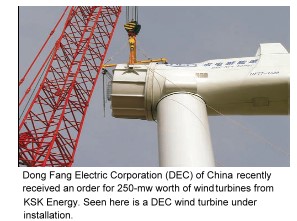
China received a big boost in India very recently when KSK
Energy placed a large order of 125 turbines of 2-mw each on
Shanghai Electric Company. For the Chinese company, it was
a significant penetration of global markets, considering that
before this, it had sold only five turbines outside its home
country. In late 2010, the same developer KSK Energy decided
to source 66 units of 1.5-mw direct drive turbines from
Chinese player Donfang Electric Corporation.
China's role in India's thermal power generation has been a
subject of big debate, and in the coming years, one may witness
wind energy toeing the line.
CONCLUSION
The Indian WTG manufacturing industry is seen maturing.
Smaller players-those that made turbines of 250kW or
lower-are disappearing, making space for global names.
With India expecting to add around 2 GW of new wind
power capacity per year, the WTG industry needs to keep
pace. Most of the international giants have had a long
presence in India, and those who did not, are following fast.
Given India's wind power potential, there is tremendous
scope for domestic WTG capacity. This apart, there is also
great export potential, particularly of sophisticated wind
turbines for offshore applications.
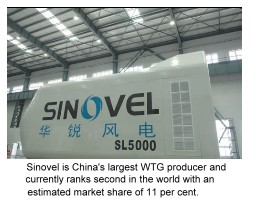
The biggest hurdle that one needs to encounter is the
absence of a robust supply chain and weak logistical support.
In fact, these are the very issues are impinge upon India's
efforts to build capacity in the manufacturing sector, even
generally speaking.
The issues in creation of WTG capacity is reminiscent of
what is happening in the thermal power equipment spaceemergence
of new players, progressive growth in technology
and a growing "interest" from China. India's Sino neighbour
has created tremendous WTG manufacturing capacity given
that it has commissioned 40 GW of wind farms over the past
four years, largely with domestic equipment. India's approach
to Chinese wind turbines, amidst the growing number of
domestic options available, would be worth observing.